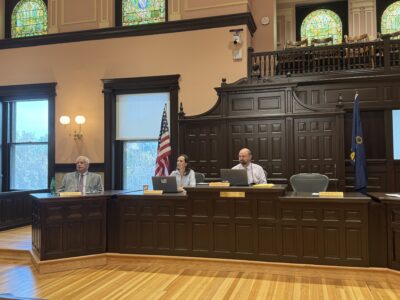Thanks to her descendant, a Lawrence woman’s act of heroism during Quantrill’s Raid is now commemorated on her grave

photo by: Bremen Keasey
Detail of the site of Emily Hoyt's gravesite in Oak Hill Cemetery in East Lawrence. Hoyt's grave previously was only labeled with a headstone reading "Mother;" her great grandson Sam Seetin pushed to add another plaque to celebrate Emily's full story.
Sam Seetin has a deep connection to the tumultuous, bloody history of Lawrence’s earliest days.
Any proud Lawrencian and longtime Kansan knows the stories of Lawrence’s founding and the decades before and during the Civil War — supporters of slavery moving in to try to vote Kansas in as a slave state, abolitionist groups from Massachusetts sending migrants, John Brown, Quantrill’s Raid. Those are as fundamental to the character of Lawrence as the Kansas River.
But Seetin, who lives in Georgia, can actually trace his lineage back to someone who lived through that history and took a stand against William Quantrill’s raiders: his great-grandmother, Emily Hoyt, who came from Boston like many other abolitionists to settle in Kansas.
Hoyt lived a pioneering life. After moving to Lawrence in 1854, she divorced her husband and ran a boarding house at what is now 743 Indiana St. And when she protected her house — with her children inside — against the raiders who surrounded it in 1863, threatening to burn it down, that place took on significance as “far more than a boarding house,” according to an obituary written for her in 1892.
But when Seetin visited Lawrence and learned more about his family’s history, he also found that Hoyt’s gravestone did not tell the full story of her life. The only description the stone gave of her was: “Mother.”
That didn’t sit right with Seetin.
“I’m going to have to do something about that,” he said.
So Seetin created a plaque to properly honor her. It credits Hoyt as a “True Heroine,” who “Midst utter chaos, bravely stood down Quantrill’s raiders from burning down (the) boarding house” — a much more fitting tribute to a woman whose bravery shaped some of Lawrence’s history and the lives of her descendants.
“She was a real hero,” Seetin said.

photo by: Bremen Keasey
A section of Oak Hill Cemetery in East Lawrence for the Hoyt family, who came and settled the city in 1854 as abolitionists from New England. The great grandson of Emily Hoyt, Sam Seetin, wanted to better memorialize her part of history, and helped install a new plaque telling her story better than a gravestone that said just “mother.”
• • •
There’s much more to Hoyt’s story than can fit on a simple gravestone, though, as both Seetin and the Watkins Museum of History can attest.
Will Haynes, the director of engagement and learning at the Watkins Museum, said that Emily was born in Boston in 1811. She married Lorenzo Hoyt in 1835, and the two of them moved with their five children to Kansas in October 1854.
Seetin said that when they reached Kansas City, Lorenzo ended up leaving the family to go to an experimental settlement/commune in Osawatomie, leaving Emily “destitute.” However, the Hoyts had met a man in Kansas City whose name is still familiar in Lawrence: Colonel Shalor Eldridge, who founded what’s now known as the Eldridge Hotel.
Seetin said Eldridge helped Emily out, and she started working at the hotel, then called the Free State Hotel, to make ends meet. Even after the hotel was burned down in 1856 by a raid from pro-slavery forces led by sheriff Sam Jones, Emily stuck it out and eventually was able to open up her own boarding house.
During this time, Emily was attempting to divorce Lorenzo, who, according to Haynes, had given up on the commune and moved to Lawrence where he found work as a cobbler.
Haynes said the divorce was eventually granted in February 1859, and Emily got custody of the kids. Despite her being divorced, though, Haynes said Emily “may have been politely called a widow” by people at the time.
Haynes also noted that before Kansas became a state, laws did not favor married women with regards to property rights or guardianship over children. When Kansas became a state in 1861, it was the first state to include property and guardianship rights for women, Haynes said.
• • •
On the day of Quantrill’s Raid on Aug. 21, 1863, Hoyt was at the boarding house at 743 Indiana St. with her children and guests.
Haynes said a “group of bushwhackers” surrounded the house during the raid, and a local guide who was forced by the raiders to help them told them it was run by a woman. The raiders initially didn’t believe them, but Emily and one of her daughters came out and told the raiders it was true.
Emily pleaded with the men not to burn her home since she was the only support for her family, Seetin said. And eventually, they let the house stand and moved along.
An account from Hovey E. Lowman written in 1864 confirmed the story, saying Emily’s “fine house … was not molested” by the raiders after they came upon it. When they learned “a poor widow” ran the place, they decided to let it be.
“The savages pretended to be touched by the pity of civilized humanity, and promised the house and its inmates immunity from the destroying touch of the bushwhackers’ hand,” Lowman’s account continued. “The promise was well kept, and the credit should not be wanting.”
Seetin said Emily’s actions saved not just her house, but her son CH Hoyt, who was a corporal in the army on leave from Fort Leavenworth. Once the raiders left, CH came out from the cupola of the house he was hiding in and ran out and hid in the cornfields before he got back to duty.
Emily’s act of bravery was something continued by her descendants. CH became a cavalry officer and was part of the 19th Kansas Cavalry Regiment that fought in the West after the Civil War. Seetin’s father, in turn, was inspired by CH to join the military. He said his father ended up retiring as a major in the Air Force after fighting during World War II. And Seetin himself had a career in the Army and eventually retired as a lieutenant colonel.
That lineage would not be possible without Emily’s moment of bravery during an infamous moment in Lawrence’s history. And now, thanks to her descendant, her heroic story is on her marker for all to see.
“161 years later from the act of heroism, she finally is honored,” Seetin said.







